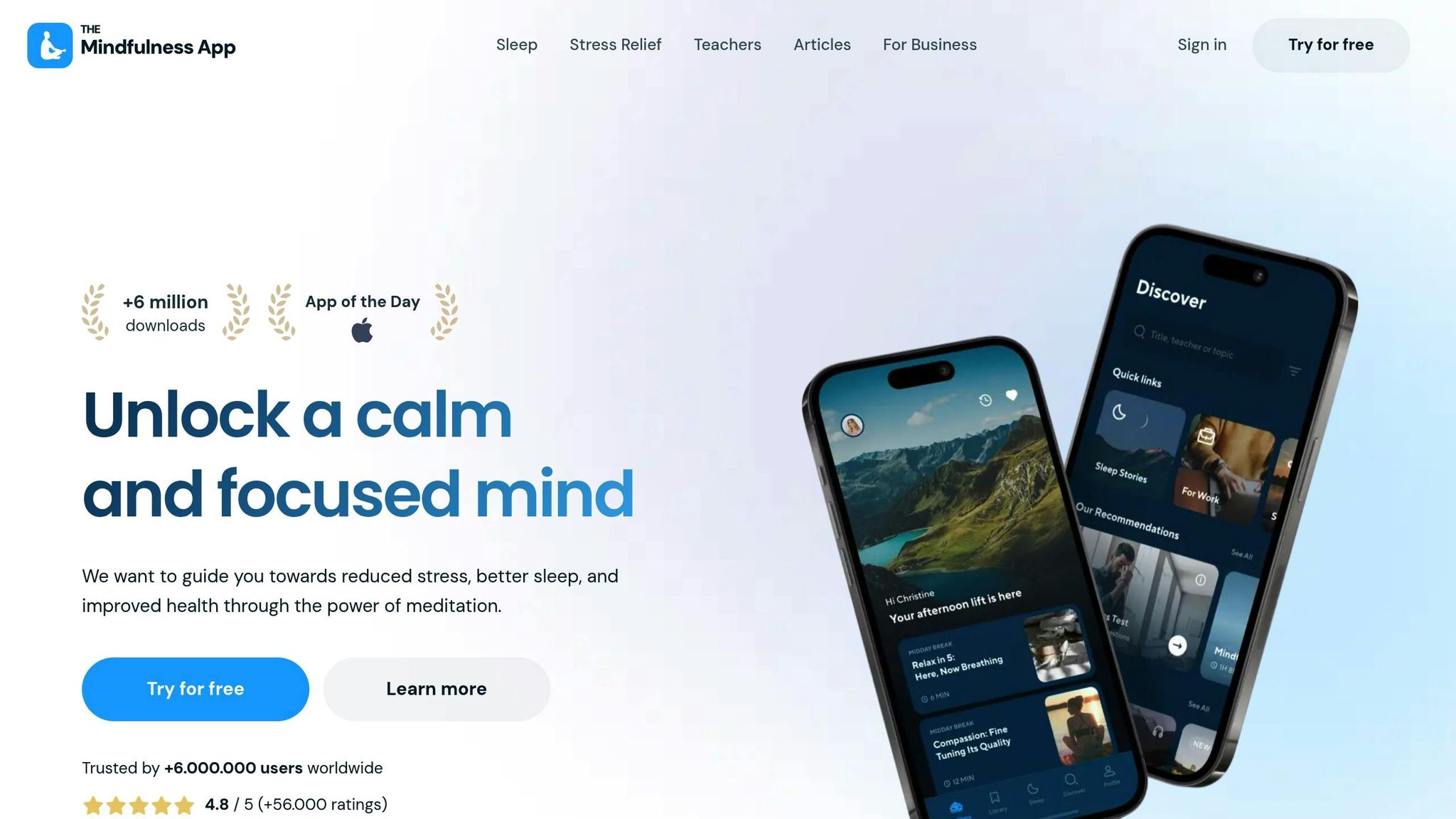Is work too much? Between non-stop emails, tough deadlines, and loud places, stress might get to you. But here's some good news: little steps in mindfulness can help you get your focus back, cut down stress, and do better in your work.
Key Points:
- Big Stressors at Work: Too much tech use, doing many things at once, and loud areas hurt focus and bring about burnout.
- Mindfulness Helps: Lowers stress, makes focus clearer, betters choices, and sets a firm line between work and home life.
- Short Tricks to Use:
- Breathing exercises: Try box breathing (4-4-4-4) or the 4-7-8 way for quick calm.
- Body checks: Spot and ease tension in just 3 minutes.
- Focusing on one thing: Spend 15 minutes on only one task without looking away.
- Daily Steps to Take: Begin your day with a clear aim, take breaks with care, and end your day by thinking back to let go of work stress.
By using these small but helpful steps in your day, you can make a calm, more focused place to work. Start with just one trick and add more as you go - your mind (and your work) will be happy for it.
MINDFULNESS AT WORK MEDITATION | 3 Minute Reset
Easy Mindfulness Ways for Your Workday
You don't need a lot of free time to add mindfulness into your work day. These fast and easy ways fit right into your day and help you deal with stress when it's too much.
Breathing Bits for Fast Help
Your breath is a key way to calm your mind. Box breathing is good when you're upset or need to think straight. Here's how it works: breathe in for 4 counts, hold for 4 counts, let it out for 4 counts, and hold for 4 counts. Do this 3-4 times, and you’ll see your heart rate go down.
For a fast change, try the 60-second breath reset. Just watch your normal breath for one full minute. Count each breath to 10, then begin again. This is good to calm down before something big or a tough talk.
Another good one is the 4-7-8 tactic, which helps when you're worried. Breathe in through your nose for 4 counts, hold for 7 counts, and breathe out through your mouth for 8 counts. The long breath out helps your body relax, making it a fine choice during lunch breaks or between meetings.
The best part? You can do these bits anywhere - whether you're at your desk, in the restroom, or during an online meet (with your camera off, surely). They are easy but good ways to get back control when work stress builds up.
Body Scans and Muscle Ease
Once your breathing is steady, move your focus to your body. Stress often hides in tight spots, but a 3-minute body scan can help you find and ease it before it hurts.
Start at the top of your head and work down, watching areas like your forehead, jaw, shoulders, hands, and legs. Calm each spot as you go. If you type a lot, think about your hands and wrists. Make fists, then spread your fingers wide, and roll your wrists in small circles to ease the strain.
Don’t forget about your legs. Sitting a lot can make your hips and legs tight. While sitting, lift one leg and turn your ankle, then switch. Squeeze your leg muscles for 5 seconds, then let go.
For a fast upper-body change, try the desk-friendly muscle ease. Lift your shoulders to your ears, hold for 5 seconds, then let them drop. Do this three times. Another tip? Press your hands together in front of your chest and push hard for 10 seconds to ease tension in your upper body.
End your body scan with three deep breaths, and see the change. Many find a few spots where they've been tight without knowing it.
Single-Task Focus and Digital Cuts
Being aware isn't just big on calm; it also sharpens your brain to focus. In work today, you find things pulling your attention away, but doing one thing at a time can help you get it back and do better.
Give yourself some time (try 15 minutes) to do just one thing. Close tabs you don't need, turn off your alerts, and flip your phone over. Tell yourself, "For the next 15 minutes, this is all I'm doing." When your thoughts drift, gently guide them back to what you're doing.
It helps to set rules for alerts too. Turn off email noises and only look at messages at set times - like 9 AM, 1 PM, and 4 PM. Put your phone on Do Not Disturb when you need to focus hard. You can let calls from important people come through but stop apps from taking your mind away.
Put times in your day when you don't look at any screens. Just 10 minutes away from them can freshen up your mind. Use this time to clean your desk, walk a bit, or just sit and be still.
The two-minute rule is also good for too much screen time. If something takes less than two minutes, just do it now. If it's bigger, write it down and set a later time to do it.
And, before you switch tasks, stop for just 30 seconds. This short stop lets your brain finish up the old task and move smoothly to the next one without stress from before.
Adding Mindfulness to Your Day at Work
Putting mindfulness into your work routine is simple. Just add small, steady acts like focused breaths or body scans to think clearer and work better. The key is to start with easy steps and keep at them until they're easy for you.
Morning Start and Quick Acts
How you start your day sets the tone for everything that comes after. Before you dive into emails or meetings, take 2-3 minutes to find your center. This small act can help you focus better and stay calm as you work.
A good start is a morning aim exercise. As you sit at your desk, take five big breaths and think, "What do I want to bring to my work today?" Maybe it's calm, new thoughts, or just being patient. This thinking time helps you work with a goal, not just react to new things that come up.
A quick check of your body is also useful. Take a bit to feel any tight spots. Set a reminder for 9:00 AM to stop and take three deep breaths. Even just enjoying your morning coffee or tea slowly - focus on how it smells and tastes - can make you feel more there.
As the day goes on, these mindful times can turn into breaks for moving and checks on how you're sitting to keep you rooted.
Midday Breaks and Check Your Sitting
By noon, stress can start to show, and sitting a lot can hurt. This is a great time for a quick break to clear your head and help your body.
Take a fast 3-minute walk. It doesn’t need to be far - a trip to the water cooler or around your building is fine. Feel your feet as they move and look around without thinking good or bad.
Checking how you sit is just as key. Are you bent over? Are your shoulders tight and high? Take 10 deep breaths as you fix your sitting - pull your shoulders back and sit up straight. These small moves can stop pains like headaches or back soreness.
If you work at home, get outside for a few minutes during lunch. Feel the breeze, see the sky, and let this quick touch with nature lift your mood and energy for the rest of the day.
As nighttime nears, moving into a wind-down routine can help you smoothly go into your own time.
End Your Workday and Think Back
How you end your day at work is as key as how you begin. A smart wind-down can make you leave work stress and get ready for a good night and relaxation.
Take some time to think about the good parts and hard times of your day before you close it out. This isn't about being perfect - it's about seeing your hard work and growth. Ask yourself things like, "What did I learn today?" or "What am I happy about from today?" These thoughts can help you deal with your feelings instead of keeping them with you at night.
Deep breaths can also help you let go of stress from work. When you breathe out, picture yourself dropping any upset or worries from the day.
Setting a regular after-work habit can tell your brain it's time to change focus. Whether it’s closing your computer on purpose, getting out of work clothes, or writing down three good things you did, these little steps make a clear line between work and home life.
Lastly, list your main tasks for tomorrow before you end your day. This easy act can clear your head, letting you rest until it's time to go again the next day.
sbb-itb-bea8dce
How to Set Up Mindful Work Plans
When firms bring mindfulness to their crew, a good plan can help a lot with both staff well-being and job outcomes. The main point is to add mindfulness into daily tasks, aiding group folks in making habits that boost focus and cut stress.
Types of Programs and Ways to Start Them
There are many ways to bring mindfulness into work, each with its own good points. Here are some ideas:
- Quick training programs: These are good for fast impacts. Often 6–8 weeks long, they teach key things about mindfulness, like how to breathe, handle stress, and keep focused. Sessions are usually 30–45 minutes once a week, fitting well for busy groups.
- Ongoing wellness programs: Rather than a short train phase, this choice mixes mindfulness into everyday work flow. For example, meetings might start with a two-minute breathing task, quiet spots may be set up for calming breaks, or weekly tips might be shared to keep staff calm in busy times. This makes mindfulness feel like a normal part of the day, not an extra job.
- Self-led programs: These let staff take part in mindfulness on their own terms. Firms can offer tools like guided meditation apps, online classes, or a set of mindfulness bits. This way works well for remote groups or staff with different times.
Some groups use a mix of these ways - like starting with quick training to show the basics and later giving ongoing or self-led help to keep going.
The best way depends on your work scene. Fast-paced spots might like quick, clear methods, while big places may have the stuff to back broader plans.
Starting Up and Checking the Effects
Setting up a mindfulness plan doesn’t need to be hard or costly. The best moves start small and grow with feedback from the staff.
- Begin with keen team folks: Find staff who already want to know about mindfulness or handling stress. These early users can make mindfulness seem normal and show others that it's simple and useful.
- Make it easy to try: Make it simpler for people to join in. Offer short, five-minute steps that fit into usual breaks or add mindfulness to regular meetings. Don’t ask for long-term joins or plans outside work times.
- Lead by act: When bosses and team heads use mindfulness steps - like taking calm breaks or breathing methods before big talks - it shows that these tools are worth trying.
- Check the results: Before starting, get some starting data. Have staff rate their stress, focus during meetings, and feelings of being swamped on a scale from 1 to 10. After 4–6 weeks, ask the same things again to see changes. Also, watch clear results, like fewer sick days, smoother meetings, or less group issues.
- Keep getting input: Have surveys every month or casual talks to learn what's good and what isn't. Plans that change from real input often do well.
Keep an eye on who takes part too - it can give ideas without making workers feel watched. For example, check how many use a calm room, go to extra classes, or use peace tips. The aim isn't full join-in; it's to give ways for staff to cope when work is too much.
Use The Mindfulness App for Calm and Clear Minds at Work

The Mindfulness App is made to help you keep calm and stay sharp at work, even when it gets busy. With more than 500 tracks in 12 tongues, it gives you guided meditations and sleep tales to cut stress and keep you balanced. Here’s how you can add these tools to your day.
Guided Meditations and Help for Sleep
Work worry doesn’t end when the work day does - it might stick with you, mess up your sleep, and hurt how well you do the next day. The Mindfulness App helps by giving guided meditations and sleep stories for both day stress and night rest. Whether you need a fast break between talks or a long time during your midday break, the app has choices for your timetable.
On hard days when sleep is hard to find, the app’s sleep tales give a soft way to ease into sleep. Plus, you can get sessions ahead of time, so you can use these calm tools even if you have no web.
Meditations Made Just for You
The app doesn’t use the same fix for everyone. It makes meditation plans just for you. These can fit into your day, be it a fast mindfulness bit during a break or a short sit-down to shift from work mode to home mode. This makes it easy to add mindfulness to your day without cutting into your work.
Start with a 14-Day Free Try-Out
Want to see how mindfulness can change your work day? The Mindfulness App gives you a 14-day free try, with full use of its best stuff. In this time, you can see what fits best in your day. You can also use the app offline, grabbing meditations to use on your way to work or during quiet times away from your desk. It’s a great way to see how mindfulness can make your work life more calm and clear.
Ending: Make Calm and Clear in Work
Making a calm and clear place at work means more than just feeling good - it helps you work in a better way. By adding moments of calm into your day, you gain tools to deal with hard things with more calm and focus.
The ways we talked about are easy, but they work well. A fast two-minute calm breath break between meetings can help you focus again. A quick scan of your body at lunch might find and ease stress you did not know was there. These small steps can bring fast help, making you more sharp and less stressed.
While it takes time to make these habits, you could see good effects really fast. In a few days, you might find you are less worried by stress, you stay on task better, and you think more clearly when you make choices.
The key is to keep at it, not to be perfect. You don't have to sit and think for an hour or change up your desk all in one go. Start little. Maybe try a morning calm time to begin your day right, or check your sitting posture in the afternoon. Pick one thing that fits easy and stick with it for a few weeks.
Today's tools make this even simpler. Apps and digital helps can lead you through calm moments when you need them - maybe when you are on a hard call or getting ready for a big talk.
The good things reach past just you. When you are more calm and sure, you make better choices, talk better, and help make a happy work spot. Your less stress can also make others less stressed.
It all starts with one calm breath. Take that first step now, and you'll make habits that make your work life calmer and clearer for a long time.
FAQs
How can I add mindfulness to my workday without it feeling too much?
Putting mindfulness into a busy workday need not be hard. Start with easy, quick steps that fit right into your day. For instance, spend just 30 seconds on deep breaths or do a fast body check when you have a coffee break. These short stops can help clear your mind and better your focus.
You can mix mindfulness into daily tasks too. As you walk, feel your feet hit the ground. Or, while you wait for a meeting to start, focus on your breath. These small, planned acts can slowly make you feel calm and clear, even when your day is full.
How do I know if I need to use more mindfulness in my workday?
If it's tough to focus, you're tired, or you see your work getting worse, it might mean that stress and mess are getting to you. These things can mess up not just your job but also how you feel inside.
Adding mindfulness to your day can help. Small things like deep breaths, talking thoughtfully, or just minutes of quiet time can make a big change. These quick, chosen times can make you calm, less stressed, and clearer in your thoughts. Just a bit of mindful time each day can change how you deal with hard stuff and keep up with your work.
How does being mindful help teams talk well and choose wisely?
Mindfulness is key in making team talk and choices better. It brings about good listening, feeling for others, and better control of feelings. This lets team members have deeper, richer talks. It not only cuts down on mix-ups but also builds strong ties between them.
Also, mindfulness makes for a calm and sharp mind, which helps drop stress and eases fights. In such a setting, problems are solved by working together. This leads to clearer thoughts, wiser choices, and a stronger bond within the team.






